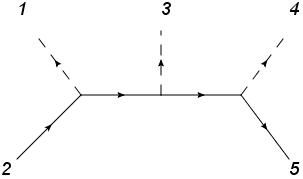$\require{cancel}$
I am trying to do an exercise from Scattering Amplitudes By Elvang (Exercise 2.9) which states:
Show that $A_5(f^-\bar{f}^-\phi\phi\phi) = g^3\frac{[12][34]^2}{[13][14][23][24]} + 3\leftrightarrow 5 + 4\leftrightarrow 5$ in Yukawa theory
So, I draw the feynman diagram, which I think looks something like this (the interaction term is $L_i = g\phi\psi\bar{\psi}$):

Is this diagram correct? Using the Feynman rules for Yukawa theory (in the Massless Spinor Helicity formalism) I evaluate this to be:
$$
A_5(f^-\bar{f}^-\phi\phi\phi) = g^3\langle2|\frac{(\cancel{p_1} + \cancel{p_2})}{(({p_1} + p_2)^2}\frac{(\cancel{p_1} + \cancel{p_2} + \cancel{p_3})}{(p_1 + p_2 + p_3)^2}|5\rangle \\~~~\\+ ~1\leftrightarrow 3 + ~1\leftrightarrow 4 + ~3\leftrightarrow 4
$$
My strategy thus far has been calculate the first term then simply do the permutations at the very end. In general, is this a good strategy to take with diagrams like this?
Doing this, I end up with the following for the first term:
$$
A_5^{(1)} = g^3\langle2|\frac{s_{13}}{s_{12}(s_{12} + s_{13} + s_{23})}|5\rangle
$$
Where $s_{ij} = -(p_i + p_j)^2 = 2p_i\cdot p_j$ and I have used the Weyl equation $\langle 2|p_2 = 0$.
I can go further, using the fact that $s_{ij} = \langle ij\rangle[ij]$, to end up with:
$$
A_5^{(1)} = g^3\langle2|\frac{\langle 13\rangle[13]}{\langle 12\rangle[12](\langle 12\rangle[12] + \langle 13\rangle[13] + \langle 23\rangle[23])}|5\rangle
$$
I can't seem to simplify this further. Am I going the right away about solving this? Are there any tricks I am missing?
 Q&A (4848)
Q&A (4848) Reviews (202)
Reviews (202) Meta (439)
Meta (439) Q&A (4848)
Q&A (4848) Reviews (202)
Reviews (202) Meta (439)
Meta (439)